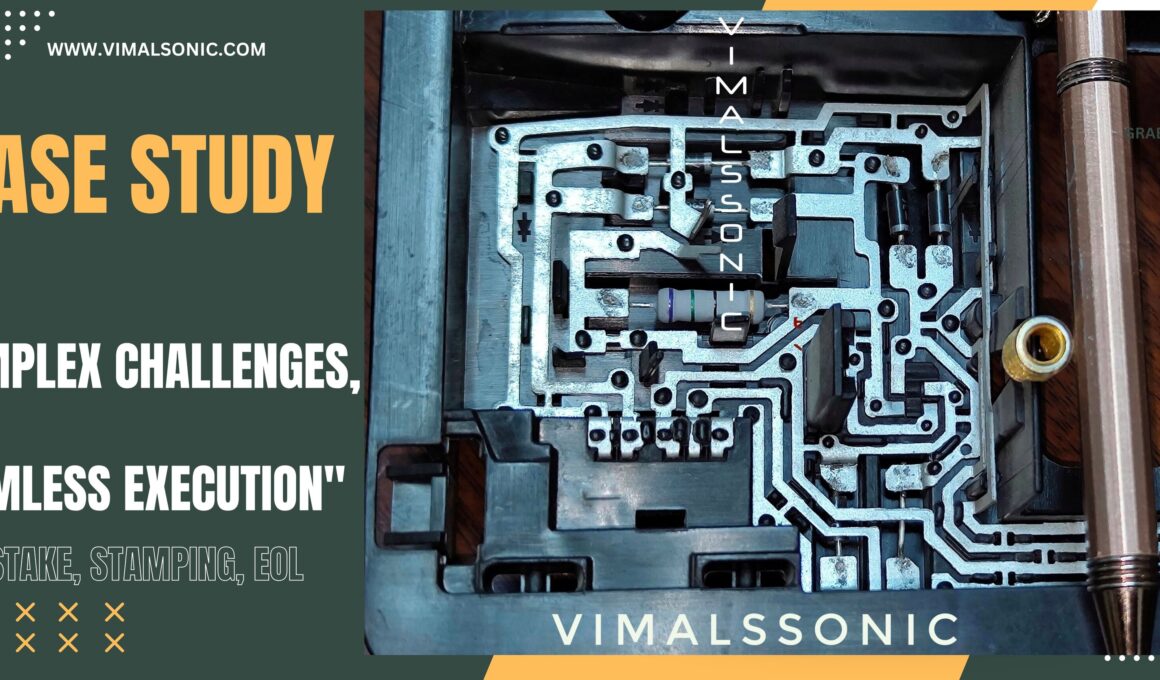Heat Staking A Case Study Project Overview
The customer, known for producing critical automotive components, encountered significant difficulties with a newly developed part that integrated electro-mechanical elements with plastic operational and decorative parts. This component required precise assembly operations on both the “A” and “B” surfaces, demanding seamless integration with other subassemblies. Misalignment or errors could compromise the functionality of the entire system, creating a pressing need for a reliable, high-precision assembly solution.

Initial Challenges
Vimalssonic was brought in to address several critical challenges:
- Assembly Consistency: Ensuring the assembly’s shape and consistency after joining each joint was crucial. Any misalignment could disrupt the functionality of electrical and mechanical subassemblies.
- Cycle Time Constraints: The project was under strict time constraints, requiring Vimalssonic to develop a solution that could maintain high standards of quality while adhering to tight deadlines.
- Complex Design: The component’s design involved the assembly of plastic and metal parts with varying diameters of staking points within a compact area. This complexity required a solution that could handle multiple operations in one cycle.
Problem Statement
The component was a subassembly for a vehicle dashboard, necessitating heat staking, stamping, and continuity checking within a single cycle. Each operation had to be performed with high precision, and any deviation could impact the component’s performance in the final assembly. Vimalssonic’s task was to design a solution that would maintain the integrity of the component while meeting stringent cycle time and quality requirements.
Quality and Time Requirements staking
Vimalssonic approached the project with a rigorous feasibility study, focusing on the following:
- Quality Standards: The project demanded precise tolerance levels, surface finishes, dimensional accuracy, and error-proofing mechanisms (poka-yoke) to prevent assembly errors.
- Timeline: The entire project, from design to prototype development, testing, and final delivery, had to be completed within 9 weeks. The solution also needed to meet specific cycle time objectives for the three operations.
Design and Development process heat staking
Vimalssonic’s engineering team embarked on a detailed design feasibility study, considering the unique requirements of the plastic component. The heat staking, stamping, and continuity checking operations required careful spacing and alignment, with staking points ranging from 0.7 mm to 11 mm in width. The team developed innovative design concepts and tools to meet these exacting standards.
During the prototype development phase, Vimalssonic conducted a Failure Mode and Effects Analysis (FMEA) and performed manual trials to refine the design. This iterative process ensured that the final machine met all quality and performance criteria.
Innovative Solution
Vimalssonic provided a comprehensive solution through a three-stage machine that integrated poka-yoke mechanisms and custom assembly solutions. Key features included:
- Online Data Acquisition: Vimalssonic’s control design team implemented a real-time data acquisition system to monitor process parameters and validate each part during stage-wise operations.
- Specialized Tools: Custom tools and horns were developed to handle the specific material requirements and maintain cycle stability.
- Seamless Integration: The machine was designed to perform heat staking, stamping, and continuity checking in one cycle, ensuring efficient production without compromising quality.
Outcomes and Collaboration
Vimalssonic maintained close collaboration with the customer throughout the project. Weekly updates ensured that the project remained aligned with the customer’s expectations, and internal trials were conducted to refine the assembly process.
- Internal Trials: The initial trials on seven components were successful, though some minor adjustments were made to improve performance.
- Final Product Performance: After refining the design, a 100-component cycle run was conducted, achieving improvements in cycle time, defect reduction, and overall product quality. The final product met all of the customer’s requirements, leading to a successful installation and training phase at the customer’s facility.
Customer Feedback
The customer expressed high satisfaction with Vimalssonic’s solution, noting significant improvements in assembly consistency, cycle time, and overall product quality. The success of this project underscored Vimalssonic’s expertise in delivering custom assembly solutions that meet the complex demands of the automotive industry.
Vimalssonic’s ability to tackle complex challenges with innovative solutions sets it apart as a leader in assembly automation. From initial feasibility studies to final production, Vimalssonic’s commitment to quality and precision ensures that customers receive reliable, high-performance assembly solutions.
Let’s Turn Your Assembly Challenges into Success Stories – Reach Out to Vimalssonic Today!

